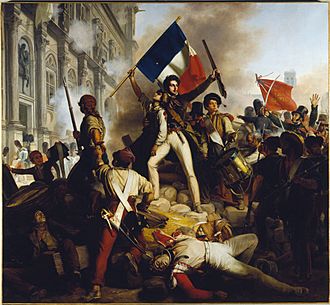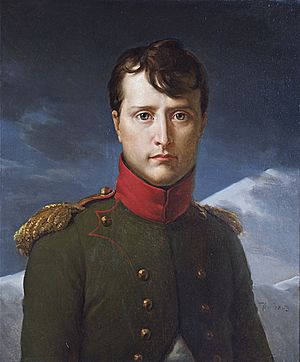July Revolution facts for kids
- This article is about the French Revolution of 1830. The better known French Revolution started in 1789.
| Part of Bourbon Restoration | |

Battle outside the Hôtel de Ville, by Jean Victor Schnetz: an allegorical painting of the July Revolution.
|
|
| Date | 26–29 July 1830 |
|---|---|
| Location | France |
| Also known as | The July Revolution |
| Participants | French society |
| Outcome | Abdication of Charles X Ascension of Louis Philippe to the French throne and establishment of the constitutional July Monarchy |
The French Revolution of 1830, also called the July Revolution, was a big change in France. It happened when Charles X was removed from power. His cousin, Louis-Philippe, the Duke of Orléans, became the new king. This event changed France from one type of monarchy (the Bourbon Restoration) to another (the July Monarchy). It also shifted power from the House of Bourbon to the House of Orléans. People who supported the old Bourbon kings were called Legitimists. Those who supported Louis-Philippe were called Orleanists. Louis-Philippe ruled as "King of the French" until the French Revolution of 1848.
Contents
Why Did the July Revolution Happen?
On September 16, 1824, Charles X became the King of France. He was the younger brother of Louis XVIII, who became king after Napoléon Bonaparte was defeated. Both Louis and Charles believed they had the right to rule because they were born into the royal family, not because people chose them. This idea was one of the reasons for the "Three Glorious Days" (Les Trois Glorieuses) of the July Revolution.
Europe After Napoleon
When Napoleon gave up his power in 1814, Europe was in a lot of confusion. Leaders from many European countries met at the Congress of Vienna. They wanted to redraw the political map of the continent. Four main powers made most of the decisions: the United Kingdom, Austria, Russia, and Prussia.
A very important person at the Congress was Charles Maurice de Talleyrand. He was a French diplomat who had worked for Napoleon. France was seen as an enemy country. Talleyrand suggested that Europe should go back to its old, "legitimate" governments. He meant the governments that were in place before Napoleon.
France Returns to Monarchy
The Congress largely agreed with Talleyrand's plan. France returned to its 1789 borders. The House of Bourbon, the old royal family, came back to the throne. The Congress thought that everything in France and Europe was now back to normal. However, the new king, Louis XVIII, knew that ideas like nationalism (strong loyalty to one's country) and democracy (rule by the people) were still popular in France.
So, they created and signed the Charte constitutionnelle française, also known as La Charte. This was a French Constitution. This constitution was the second main reason that led to the July Revolution. It tried to balance the old ways with new ideas.
What Was the Outcome of the Revolution?
The July Revolution of 1830 led to a constitutional monarchy. This meant the king's power would be limited by a constitution. On August 2, Charles X and his son, the Dauphin, gave up their rights to the throne. They then left for Great Britain.
Charles X wanted his grandson, the Duke of Bordeaux, to become King Henry V. But the politicians who formed the temporary government chose a distant cousin instead. This was Louis Philippe from the House of Orléans. He agreed to rule as a constitutional monarch. This time in French history is known as the July Monarchy.
The July Column, located in Place de la Bastille, remembers the events of the Three Glorious Days.
Impact Beyond France
This new French Revolution also inspired other uprisings. An August uprising in Brussels led to the separation of Belgium from the United Kingdom of the Netherlands. This created the Kingdom of Belgium. The July Revolution also sparked unsuccessful revolutions in Italy and the November Uprising in Poland.
Two years later, some students in Paris were unhappy with the revolution's results. They started another revolt known as the June Rebellion. Even though this uprising was quickly stopped, the July Monarchy remained unpopular. Both supporters of the old ways and those who wanted more change disliked it. Eventually, the July Monarchy was overthrown in 1848.
Images for kids
-
Charles X in coronation robes, by Robert Lefèvre
-
Scenes of July 1830, a painting by Léon Cogniet about the July revolution of 1830
-
The arrival of the duc d'Orléans (Louis Phillipe) at the Palais-Royal, by Jean-Baptiste Carbillet
-
Louis-Phillipe going from the Palais Royal to the Hôtel de Ville, 31 July 1830, by Horace Vernet
-
Eugène Lepoittevin, Souvenirs patriotiques no. 2, 1830, Bibliothèque nationale de France
See also
 In Spanish: Revolución de 1830 para niños
In Spanish: Revolución de 1830 para niños


















